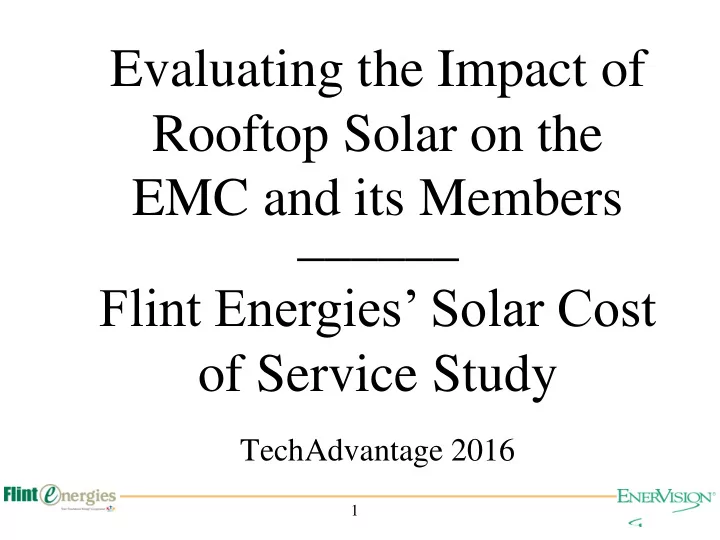

Evaluating the Impact of Rooftop Solar on the EMC and its Members ______ Flint Energies’ Solar Cost of Service Study TechAdvantage 2016 1
Introductions Background Cost Study Objectives Study Process Results Next steps 2
Ty Diamond, Chief Operating Officer, Flint Energies Joshua Warmack, Vice President, Emerging Energy Solutions, EnerVision 3
Flint Energies . . . Provides electricity to parts of 17 central Georgia counties Serves more than 87,000 meters Delivers over more than 6,600 miles of distribution line and 50 substations Has a peak over 500 MW Participates in solar and other renewables through direct PPA and participation in Green Power EMC 4
EnerVision . . . Provides a full range of business- related services to cooperatives nationwide Business lines include – Emerging Energy Solutions – Management Consulting Services – Power Supply Services Headquartered in Atlanta, Georgia 5
Background Flint Energies had several net metered rooftop solar installations and was receiving frequent inquiries. Those inquiries were expected to increase with the passage of Georgia’s third party financing legislation. 6
Flint EMC’s net metering policy provided for members to offset purchases with rooftop solar and sell excess back at avoided energy cost. State law provides options for Flint EMC to consider in handling of member rooftop solar Before considering policy changes, Flint wanted to better understand the impacts of rooftop solar on the system. 7
The Flint staff had experience- based assumptions about the system cost impacts of member rooftop solar installations . . . . . . but wanted to act based on facts. 8
Study Objectives Determine the costs and benefits to Flint EMC associated with member solar installations Establish a methodology to determine an appropriate maximum amount, if any, of rooftop solar on the system Evaluate options to gain maximum benefit from member solar installations 9
Benefits & Costs Studied Potential Benefits Potential Costs Purchased power cost Reduced kWh sales = reductions reduction in recovery of fixed and variable costs Transmission & distribution losses Member services time Distribution facilities Initial customer-site savings facilities Environmental Billing and accounting compliance Ongoing operations effort 10
Study Process Internal data – Interviewed and collected data from Flint staff in all areas Solar data – Compiled generation data available from member rooftop installations – Obtained industry-standard model solar generation data Power cost – Determined all power contracts and cost components impacted by member solar 11
Internal Data Interviewed – Member Services group – Engineering staff – Operations staff Determined time spent and direct expenses related to rooftop solar 12
Solar Data Compiled hourly data for each rooftop solar member (in EMC data library) – Analyzed data to determine a typical generation profile – Insufficient data to compile a profile Utilized industry-accepted data to a model generation profile for service territory (NREL’s PV Watts) 13
Power Cost Analysis Used load profile data to determine – Impact on peak and base/intermediate capacity needs – Reduction in energy purchases – Reduction in network transmission purchases Evaluated economic impact of each factor under Flint’s power purchase and transmission agreements 14
Interesting Finding While we thought of solar as peaking generation, the impact on system load shape occurred in enough hours to reduce base/intermediate needs as well. 15
Impact of Rooftop Solar on Load Duration Curve 16
System Rooftop Solar Costs One-time costs well in excess of amount recovered through current net metering policy – Receiving and responding to inquiries – Interconnection design and agreement – Installation of Flint facilities Revenue reduction due to member generation offsetting purchases from Flint (except some accounts on demand rates) Recurring monthly expense of $25 per member installation for handling inquiries, billing and ongoing support Recurring monthly expense associated with isolating DG installations during outage & maintenance activities 17
System Rooftop Solar Benefits Reduction in wholesale power cost Reduced transmission & distribution losses, reflected in lower power costs Anticipated contribution to Clean Power Plan compliance, but too soon to quantify any value While solar generation reduced exposure to volatile fuel prices, rate stability seen as a qualitative benefit Distribution facilities savings – study concluded little to no savings 18
Study Conclusions Member rooftop solar installations provide greater power cost savings than similar utility scale solar Under current rates and costs, member rooftop solar installations result in subsidization & thus there is no level of solar beneficial to the system Structuring compensation to encourage peak maximizing solar installations would be beneficial, though not eliminate subsidization With appropriate rate structures, all rooftop solar could conceptually be beneficial to Flint EMC 19
Peak Maximizing Solar Typical solar installations maximize the energy generated by the unit rather than demand reduction during peak Installations made to maximize peak reductions could potentially double capacity benefit Flint realizes while reducing energy generation by 10% to 20% Following charts reflect costs and benefits to Flint for solar installations made with objective of maximizing peak reductions 20
21
22
Rooftop Solar in Cost of Service Study Member Using 10 kW With & Without Rooftop Solar 10 kW Member with Member 10 kW Rooftop Without Solar Solar Revenue 1.0 .60 Expenses 1.0 0.75 TIER from Operations 1.0 (1.45) Revenue Increase Needed to Equal TIER 26% Without Solar 23
Members’ solar generation is NOT the problem . . . . . . it’s the failure of the rates members are being charged to properly recover Flint’s cost to serve them 24
Solving the Problem Align cost recovery through rates with cost causation Reduce or eliminate fixed cost recovery through energy charges – Higher base charges – Demand charges – Service charges Implement Time of Use rates to align cost recovery with timing of costs 25
Closing Comments and Questions 26
Recommend
More recommend